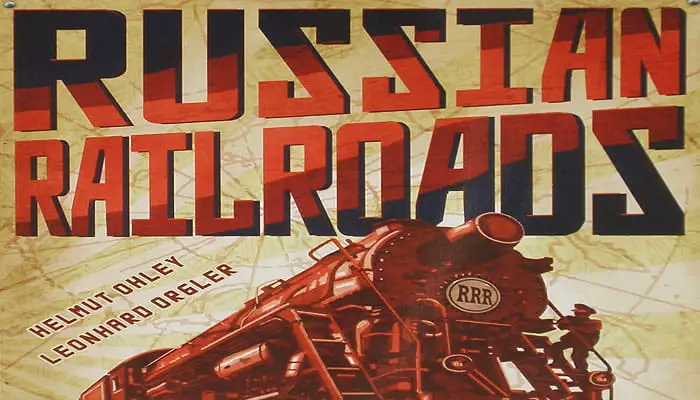
Components

- 1 game board
- 35 workers
- 8 pawns
- 48 tracks
- 8 Industry markers
- 4 player boards
- 37 locomotives
- 15 engineers
- 20 Doubler tokens
- 18 roubles (.coins)
- 28 ? tokens and 5 ? cards
- 4 Revaluation markers
- 4 Kiev Medals
- 1 Last Round marker
- 8 point tokens
- 10 End Bonus cards
- 4 Turn Order cards
- 4 Starting Bonus cards
- 4 Scoring Overview cards
- Rulebook
Setup

-
Place the game board in the middle of the table. Place the 100/200 and 300/400-point tokens near space 100 of the scoring track.
-
Lay the 5 cards
 face up.
face up. -
Shuffle the 10 End Bonus cards and remove two of them from the game without looking at them. The 8 remaining cards form a face down pile.
-
Place the 37 locomotives next to the board so that they are locomotive side up (the purple side will come up later). Sort them by number and place them so that they form 9 distinct piles as seen below. (One of the #9 locomotives has no purple backside and should be placed on its matching
 card).
card). -
Place the 2 turquoise workers on the area of the board displaying 2 turquoise workers. Place the black worker on its matching
 card.
card.Give each player 7 of the workers in their player color (1 worker of each color is returned to the box).
-
Form a Doubler token supply using the 20 Doubler tokens (called "doubler" for the remainder of this rulebook).
-
Form a supply with the 18 roubles (coins).
-
Form a track supply by sorting the 48 tracks so that they are grouped by color.
-
First, sort the 15 engineers into El and E piles. ( One engineer is not marked with a letter and should be placed on its matching 0 card along with a single rouble).
Shuffle the
 and
and  piles separately. Place the top 4 engineers of the
piles separately. Place the top 4 engineers of the  stack on the spaces marked
stack on the spaces marked  . Place the top 3 engineers of the
. Place the top 3 engineers of the  stack on the spaces marked
stack on the spaces marked  . Remove the remaining engineers from the game.
. Remove the remaining engineers from the game.Engineers placed horizontally should be light side up. Engineers placed vertically should be dark side up. (The engineers and the spaces they occupy have a distinctive form to help remind players which side should face up).
-
The Last Round marker is placed near the game board. It will be required for the last round of the game.
Player Board

-
Each player selects a color and places the matching player board in front of herself.
-
Each player receives a #1 locomotive from the supply and places it on the appropriate space at the upper left of her player board.
-
Each player receives 3 black tracks from the supply and places them on the first space of each of the three railroads pictured on her player board.
-
Each player receives 5 workers in her color and places them before her. The remaining 2 workers are placed near the game board in a supply.
-
Each player receives 1 rouble from the supply.
-
Each player receives 1 Industry marker and places it on space 0 of the industry track.
-
Each player receives 7 different
 tokens, a second Industry marker, 1 Kiev Medal, and 1 Revaluation token. She places everything near her player board.
tokens, a second Industry marker, 1 Kiev Medal, and 1 Revaluation token. She places everything near her player board. -
Shuffle the 4 Turn Order cards and place one number-side-up in front of each player.
Please note: The cards have differing backsides. It is recommended that the cards be shuffled and dealt blindly.
-
Each player receives 2 pawns in her color: one to place on the 100 space of the scoring track; another to place on the space of the turn order track matching her Turn Order card.
-
Lay out the Starting Bonus cards. The player 4th in turn order takes one, uses its ability and removes it from the game.
The player 3rd in turn order does the same, followed by the player 2nd in turn order. The player 1st in turn order receives no Starting Bonus card. The remaining Starting Bonus card is returned to the box.
-
Each player receives a Scoring Overview card.

Object of the Game
The players embody railroad moguls who have been commissioned to build the Trans-Siberian Railway, as well as two additional railroads.
In addition to track construction, the players will purchase new locomotives, promote industrialization, and hire workers and engineers. All this is done in the lofty pursuit of acquiring the most victory points - the truest measurement of a player's rail building skills.
The players take actions one after the other in order, until all players have passed. At the end of each round, players score points as a measurement of their progress.
In the four-player game, the game ends after the seventh round and the player with the most points wins.
Game Play
Each turn a player will choose an unoccupied action space, occupy it with the required number of workers and perform that action.

You must consider the following:
- You Must choose an unoccupied action space (i.e. one that is not already occupied by workers).
- You must place the correct number of workers required for the action space you wish to use.
- You must only use workers from your personal worker supply.
- You must immediately make use of the chosen action.
- You must perform the action in its entirety.
- You may perform only one action per turn.
Please note: exceptions to these rules will be noted where applicable.
Another note: We use the word "must" to ensure players clearly understand how the game is to be played. There are only positive actions. In most cases, a player will only take an action they want to perform.
Game Turn
Whatever Gorbachev meant when he uttered those words, the truth is that in this game, being first is definitely to your advantage.
In this game, players do not play in clockwise order. The turn order track is used to determine player order. The player occupying the first position plays first, followed by the player occupying the second position, and so forth. Once the last player has taken her turn, it is once again the first player's turn to play.
When a player does not wish to or cannot continue playing, she passes; this means that for the remainder of this round, she will not be able to play. Finally, to show that she is out of this round, she flips her Turn Order card and immediately scores the points shown on the back of her card.
The other players keep playing, one after the other, until every player has passed.
Note: Even if a player runs out of workers, this does not mean that she must pass right away. She can continue performing actions with roubles.
How to get ahead on the turn order track?

You can place one of your workers under the first or second position of the turn order track. This will be your position in the turn order sequence of the following round.
Note: You may not place a worker on the action space under your current position in the turn order, nor may you occupy both turn order action spaces.
How is the turn order reorganized?
Once every player has passed, the players who placed a worker under the turn order track remove their pawn. To free the turn order spaces, the other pawns are moved to the right (towards the last spaces of the turn order track). Then, the players place their pawn on the turn order space above their worker.
Special case: If the first player places a worker on the 2nd position (prob- ably because she does not wish to move further back) and that no other player places a worker on the 1st position, the turn order will not change.
Note: As you may have noticed, it is very important to know which player places a worker on the turn order action spaces. To this effect, if a player places a worker that is not of her color or a rouble, she must immediately exchange it with a worker of her color placed on another action space.
A worker on a turn order action space provides another benefit. Once the turn order has been reorganized, players who placed a worker on the turn order action spaces can each move their worker to a free action space.
The player whose worker occupies the 2nd position is first to move her worker. She takes her worker from the turn order action space and moves it to a free action space of her choice (this can be one of her engineers). She then performs the corresponding action.
Example: Red takes her worker from this space and moves it on the "1 brown track advancement" action space.

Then, the player who placed his worker on the 1st space does the same, following the same rules.
When moving your worker, you must observe the following:
You may only move your worker to an action that requires exactly 1 worker (i.e. you may not combine it with other workers, temporary workers, or roubles).
If There are no better options, you can always use the bottom track extension action.
Player Board
We will now see in detail your player board.
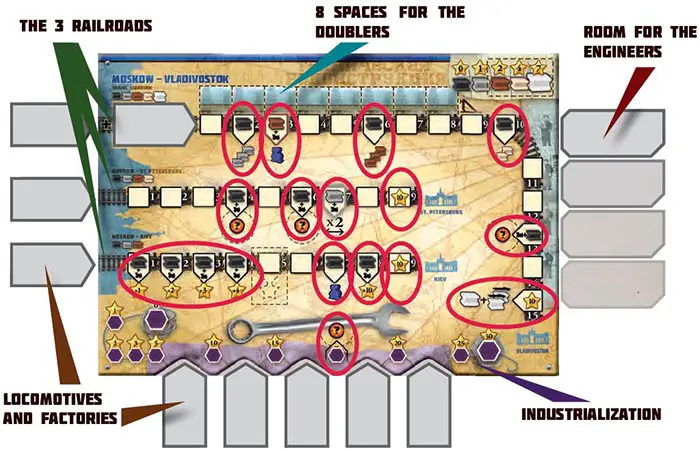
The Special Spaces On A Player Board
The spaces circled in red give you various advantages. To get these advantages (shown below the space or next to it), you must first fulfill certain conditions.

Example: To get this space's advantage, the black track must reach or pass this space. A locomotive is not necessary.

Example: The brown track on this railroad must at least reach this space. Furthermore, a locomotive must also reach this space.
In short, you must fulfill both of these conditions to obtain this advantage.
General rule: Before acquiring the advantage that a space gives, you must always at least reach the space with a track. Sometimes, a locomotive must also reach that space. T
he following pages present these special spaces in two groups: those that do not require a locomotive and those that do.
 Without a Locomotive
Without a Locomotive
-
Advantage: New Tracks

On spaces, 2, 6 and 10 of the Trans-Siberian, you get the tracks depicted below each space. ...+ 2 white track advancements

Space 15 allows you to get the white track. On top of that, you can immediately advance it up to 2 spaces.
You must follow the usual rules (only on empty spaces, no passing), otherwise you lose the advancement(s) you cannot use.
-
Advantage: Terminus

When you reach the last space of a railroad with the black track, you immediately score w" 10 points. A railroad may not be extended beyond the last illustrated space.
-
Advantage: New Worker

If you reach space 7 of the Kiev railroad with your black track, you immediately receive one worker of your color from the general supply.
You may use this worker immediately and for the rest of the game.
 With A Locomotive
With A Locomotive
-
Advantage: New Worker

If you reach space 3 of the Trans-Siberian with your brown track and a locomotive, you immediately receive one worker of your color from the general supply.
You may use this worker immediately and for the rest of the game.
-
Advantage: Value Of This Railroad Is Doubled

If you reach space 7 of the St. Petersburg railroad with your gray track and a locomotive, the value of every scored space of this railroad is doubled during the scoring phase.
-
Advantage: Bonus Points

If you reach spaces 1 through 4 or space 8 of the Kiev railroad with your black track and a locomotive, you score the points depicted in the stars during future scoring phases. These points are cumulative.
-
Advantage:
 Spaces
Spaces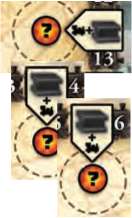
If you reach space 13 of the Trans-Siberian, or spaces 4 or 6 of the St. Petersburg railroad with your black track and a locomotive, you choose one of your 7
 tokens, apply its effect and then place that token in the dashed space with a
tokens, apply its effect and then place that token in the dashed space with a  .
.This space may not be used again to receive another token.
-
Advantage: Industry Track
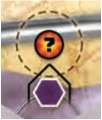
To receive this advantage, your Industry marker must reach this space on the industry track.
There is no track or locomotive requirement for this space. You then proceed as described above for the
 spaces.
spaces.This space may not be used again to receive another
 token.
token.
 Scoring Phase
Scoring Phase
At the end of each round, once every player has passed and the turn order has been reorganized, the scoring phase happens.
These two elements on each player's individual boards are scored:
- Their 3 railroads and
- Their industrialization progress.
Example: Red's player board, ready for scoring!
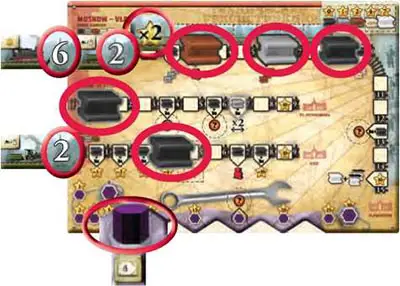
Scoring the 3 Railroads
In principle, only spaces reached by a locomotive are scored.
Each track on a railroad can score points. The value of each track is determined by its color, as shown in the upper right corner of the board.

a track scores points for the space it occupies and all empty spaces behind it. These empty spaces count as being occupied by tracks of the same color (=virtual tracks).
With this in mind, when scoring a railroad, you should visualize it as such:

The scoring of the railroads will be presented in this order: Trans-Siberian, St. Petersburg and Kiev.
Step by step scoring of the Trans-Siberian:
Example: Red has a #6 and a #2 locomotive on the Trans-siberian. Her locomotives allow her to reach space 8. Thus, Red will only score spaces 1 through 8.


Spaces 1 through 3 are occupied by brown tracks (1 real and 2 virtual). Each space with a brown track is worth 2 points. Her doubler above space 1 increases that space's value to 4 points. Her brown tracks are worth a total of 8 points.

Spaces 4 through 7 are occupied by gray tracks (1 real, and, behind it, 3 virtual). Each space with a gray track is worth 1 point, for a total of 4 points.

Space 8 is occupied by a virtual black track. It is worth 0 points. (This may not seem like a lot, but it will be worth its while in due time).
She scores a total of 12 points for the Trans-siberian.
Scoring the St.Petersburg railroad:

The spaces on this railroad are scored like those on the Trans-siberian.
Important note for this railroad: when a player reaches space 7 of this railroad with his gray rail and a locomotive, the value of all scored spaces on his St.Petersburg railroad are doubled.

Example: Red does not have any tracks on the St.Petersburg railroad (except the black one) nor any locomotives. She scores 0 points.
Scoring the Kiev railroad:
The spaces on this railroad are scored like those on the other two railroads.
The special spaces of the Kiev railroad are spaces 1 through 4 and space 8. A player that reaches theses spaces with his black rail and a locomotive will also score the points noted in the stars.
Example: Red has a #2 locomotive on the Kiev railroad. Red will thus only score spaces 1 and 2.
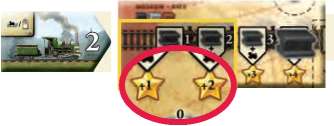
The black tracks are not worth any points, and since she has yet to build any other track colors, her tracks are worth 0 points.
However, she does score points for the first two special spaces (1 point for the fi rst one and 2 for the second one). This railroad is worth a total of 3 points.
Scoring The Industrialization
In addition to your tracks, you also score the points noted on the space on the industry track currently occupied by your Industry marker. Spaces that do not show any points (for example, the factories) are worth the same amount of points as the first previous space worth points.

Example: Red's marker is on a factory. Since this factory does not show any points, she looks at the fi rst previous space worth points; this means that she scores 5 points.
You have now seen how players score their railroads and the progress of their industrialization.
After the Scoring Phase
Once all players are done with their scoring, they must prepare the next round. To be ready for the next round:
All players must return their workers to their personal supply.
One player must return all placed roubles back in the general supply.
One player must return both turquoise workers to the corresponding action space.
One player moves the engineers.
All engineers are moved 1 space to the right. If there is still an engineer on the hiring space, that engineer is returned to the box. Engineers must always be light side up on the changing action spaces, otherwise they should be dark side up. You will need to flip some engineers when you move them from one section to the next.Finally, each player takes the Turn Order card corresponding to her new position in the turn order. That card is placed number-side-up in front of them.
Note: Each space under an engineer shows a number. This is the number of rounds left to play.
You are now ready for the next round!
Warning: This applies only for the last round:
At the beginning of the last round (round 7 with 4 players), the Last Round marker is placed over the turn order action spaces.
During the last round, these actions are useless; this is why they are replaced with a new action.
New action: 3 advancements on the industry track.
End of the Game
After the scoring phase at the end of round 7,, a final scoring takes place, and then the game is over.
The final scoring consists of 2 parts:
- The end bonus cards and
- The majority of engineers.
End Bonus Cards
Players reveal their End Bonus cards at this time.

Note: Usually, each player will end the game with one End Bonus card. However, it is possible, with the help of factories, to acquire more End Bonus cards.
It is even possible for a player to end the game without any End Bonus cards, but we strongly advise against this.
Engineer Majority
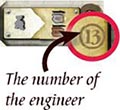
The player with the most engineers scores 40 points. The player with the second most engineers scores 20 points.
In case of a tie, the tied players look at the numbers on their engineers; the player with the engineer that shows the highest number wins the tie.
Note: A player that does not have any engineers may not score these bonus points.
The game is over after the final scoring.
The player with the most points is the winner. In case of a tie, the tied players share the victory.
Tactical Hints
Every player should read these before playing their first game:
Pay attention to the track extension actions. It is important not to forget to extend your more valuable tracks when possible.
Pay attention to the locomotives you build, and make sure that they reach the special spaces (for example, a 2 locomotive on the St.Petersburg is not very useful).
The changing action spaces (engineers) are very useful.
Roubles are more flexible than temporary workers.
You should aim to acquire at least 2 tokens.
Industrialization is worth a lot of points at the beginning. But fear not, extend- ing your tracks will pay greatly by the end of the game.
Continue Reading


